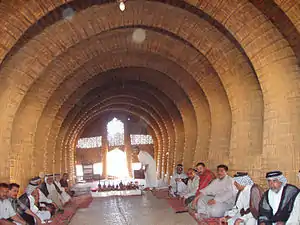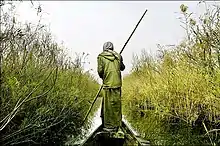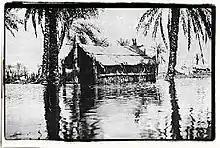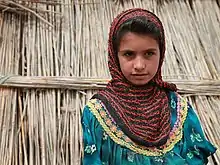Mudhif
A Mudhif /muˈdiːf/ (Arabic: المضيف al-muḍīf) is a traditional reed house made by the Madan people (also known as Marsh Arabs) in the swamps of southern Iraq. In the traditional Madan way of living, houses are constructed from reeds harvested from the marshes where they live. A mudhif is a large ceremonial house, paid for and maintained by a local sheik, for use by guests or as a gathering place for weddings, funerals, etc.


Description
Mudhif structures have been one of the traditional types of structures built by the Arabs of the marshlands in southern Iraq for at least 5,000 years. A carved elevation of a typical mudhif, dating to around 3,300 BCE was discovered at Uruk, and is now in the British Museum.[1]

A mudhif is a special type of sarifa; a structure made from reeds which grow naturally in the marshlands and is used by the village sheik as a guest-house.[2] Other types of reed dwelling, such as a raba (with entrances at both ends and used as a family dwelling) or a bayt (strictly a single-room dwelling) are typically smaller than a mudhif and may be used for residential and other purposes.[3]
Each village sheik had a mudhif capable of accommodating at least ten persons. The number of arches used in a mudhif is dictated by the tribe and family group.[4] Sometimes the mudhif was decorated with additional bundles of reeds, arranged in decorative patterns, placed on the façade, to serve as a tribal identifier.[5] The entrance to the mudhif always faces Mecca.[6]

The English writer, Gertrude Bell, wrote a description of a mudhif in a letter to her father:[7]
"After dinner Sheik Ibadi al Husain invited us to his mudhif, his guest house. Now a mudhif you can't picture until you have seen it. It is constructed of reeds, reed mats spread over reed bundles, arching over and meeting at the top, so that the whole is a perfectly regular and exquisitely constructed yellow tunnel, 50 yards long. In the middle is a coffee hearth, with great logs of willow burning. On either side of the hearth, against the reed walls of the mudhif, a row of brocaded cushions for us to sit on, the Arabs flanking us and the coffee-maker crouched over his pots. The whole lighted by fire and a couple of small lamps, and the end of the mudhif fading away into a golden gloom. Glorious.
Construction
In the construction of a mudhif, reeds are bundled and woven into thick columns; larger and thicker reeds are bent across and tied to form parabolic arches which make up the building's spine. These arches are strengthened by the pre-stressing of the columns, as they are initially inserted into the soil at opposing angles.[8] A series of arches define the building's form. Long cross beams of smaller bundled reeds are laid across the arches and tied. Woven mats of reeds form the building envelope. Some of the mats are woven with perforations like a mesh to allow light and ventilation.
The front and back walls are attached to two large vertical bundled reed columns and are also made from woven mats. Mudhif need to be rebuilt every ten years.[9]
Reeds as a construction material
The most common type of reed used for the construction of marshland mudhif is ihdri. Reed has properties which make it an ideal building material – it has a high concentration of silica which makes it water resistant, unattractive for insects and other pests and an excellent thermal and acoustic insulating material. It is an inexpensive material and it is both flexible and durable as a construction material, which encourages creativity.[10]
Use

A mudhif is used as a guest house or for ceremonial occasions, and may not be used for any other purpose. When a guest enters a mudhif, he or she will be welcomed by the village sheik, escorted to their proper place and offered refreshments such as highly sweetened coffee in a ritualised ceremony.[11]
Recent developments
In the 1980s, some half a million Arabs lived in the marshes.[12] However, from around 1993, Saddam Hussein began to drain the marshes in an attempt to destroy the life and culture of the southern Arabs.[13] Following Hussein's defeat in 2003, Arab communities began to dig up the dykes, re-flooding the marshes and resuming their traditional way of life.[14]
References
- Broadbent, G., "The Ecology of the Mudhif," in: Geoffrey Broadbent and C. A. Brebbia, Eco-architecture II: Harmonisation Between Architecture and Nature, WIT Press, 2008, pp. 15–26
- Ochsenschlager, E.L., Iraq's Marsh Arabs in the Garden of Eden, University of Pennsylvania Press, 2004, p. 162
- Ochsenschlager, E.L., Iraq's Marsh Arabs in the Garden of Eden, University of Pennsylvania Press, 2004, pp. 145–46
- The National Geographic Magazine, Vol. 113, 1958, p. 214
- Van de Noort, E., Climate Change Archaeology: Building Resilience from Research in the World's Coastal Wetlands, Oxford, Oxford University Press, 2013, p. 216
- The National Geographic Magazine, Vol. 113, 1958, p. 214
- Lady Bell (ed.), The Letters of Gertrude Bell, Vol. II, London, Ernest Benn, 1927, pp. 476–77 https://archive.org/details/in.ernet.dli.2015.210996/page/n85
- Mudhif," in Encyclopedia Britannica, Online: Archived 5 June 2022 at the Wayback Machine
- Darwish, E. A.; Mansour, Y.; Elmously, H. I. (2018). "Development of the Structural Uses of Date Palm Rachis for Cheap Wide Span Construction for Rural Communities in the Middle East". IOP Conference Series: Materials Science and Engineering. 371 (1): 012023. Bibcode:2018MS&E..371a2023D. doi:10.1088/1757-899X/371/1/012023.
- Almusaeda, A. and Almassad, A., "Building Materials in Eco-energy Houses from Iraq and Iran," Case Studies in Construction Materials, vol. 2, June 2015, pp. 42–54 Open access journal
- Ochsenschlager, E.L., Iraq's Marsh Arabs in the Garden of Eden, University of Pennsylvania Press, 2004, pp. 145–46
- "Total numbers of Marsh Arabs" (PDF). Archived (PDF) from the original on 25 July 2021. Retrieved 30 October 2019.
- "The Iraqi Government Assault on Marsh Arabs" (PDF). Archived (PDF) from the original on 15 May 2009. Retrieved 30 October 2019.
- Blue, Circle of (4 September 2013). "Iraq's First National Park: A Story of Destruction and Restoration in the Mesopotamian Marshlands". Circle of Blue. Archived from the original on 27 January 2022. Retrieved 30 October 2019.
External links
- Mudhif under construction and the Marsh Arabs